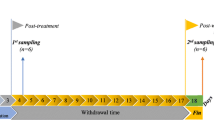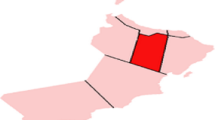Abstract
A total of 98 poultry samples, including chicken and turkey muscle, were analysed, using a sensitive and reliable analytical method based on liquid chromatography (LC) with spectrofluorimetric detection, for simultaneous determination of four fluoroquinolone (FQ) antibiotics, namely enrofloxacin (ENRO), ciprofloxacin (CIPRO), norfloxacin (NOR), and sarafloxacin (SARA). The method involved extraction with 0.15 mol L−1 HCl and clean-up by solid-phase extraction using Oasis HLB cartridges. Chromatographic separation was carried out on a C18 TSK gel column, in isocratic mode, with 0.025 mol L−1 H3PO4 solution, adjusted to pH 3.0 with tetrabutylammonium hydroxide-methanol (78:22) as mobile phase. Good linearity over the investigated concentration range was observed, with mean values of correlation coefficients higher than 0.9989 for all the analytes studied. The limits of quantification (LOQ), expressed as the lowest fortification level with acceptable precision were 15 μg kg−1 for ENRO, CIPRO, and NOR, and 30 μg kg−1 for SARA; these values are in compliance with requirements for monitoring of maximum residues levels (MRLs). Overall recoveries from spiked samples ranged from 80% to 92% with relative standard deviations (RSD) lower than 6.1%. Of the chicken and turkey samples analysed, 44.2% and 37.8%, respectively, were contaminated. The levels found in the analysed poultry samples, collected from markets of Oporto and Coimbra, located in the north and central zones of Portugal, respectively, were lower than 114.2 and 87.6 μg kg−1 in chicken and turkey muscle samples, respectively. One positive chicken sample was contaminated with ENRO at levels higher than the MRL.


Similar content being viewed by others
References
Hernández-Arteseros JA, Barbosa J, Campañó R, Prat MD (2002) Analysis of quinolone residues in edible animal products. J Chromatogr A 945:1–24
World Health Organization (WHO) (1998) Report Nº WHO/EMC/ZDI/98, Geneva, Switzerland
Food and Drug administration (FDA) (2005) FDA Announces Final Decision about Veterinary Medicine
EMEA/CVMP/SAGAM/184651/2005 (2007) Committee for medicinal products for veterinary use (CVMP), public statement on the use of (fluoro)quinolonas in food-producing animals in the European Union: Development on resistance and impact on Human and animal health
Hsu DI, Okamoto MP, Murthy R, Wong A (2005) Fluoroquinolone-resistant Pseudomonas aeruginosa: risk factors for acquisition and impact on outcomes. J Antimicrob Chemother 55:535–541
INE (2008) at http://www.ine.pt/xportal/xmain?xpid=INE&xpgid=ine_indicadores&indOcorrCod=0000211&contexto=bd&selTab=tab2. Accessed on March 2010
Al-Mustafa ZH, Al-Ghamdi MS (2000) Use of norfloxacin in poultry production in the eastern province of Saudi Arabia and its possible impact on public health. Int J Environ Health Res 10(4):291–299
EMEA Maximum Residue Levels 820/02 (2002) Final Committee for veterinary medicinal products. Enrofloxacin (extension to all food producing species). Summary report 5
Council Directive 96/23/EC. Measures to monitor certain substances and residues thereof in live animals and animal products. Official Journal of the European Union L 125, 23.5.196, p.10
Turiel E, Martín-Esteban A, Tadeo JL (2006) Multiresidue analysis of quinolones and fluoroquinolones in soil by ultrasonic-assisted extraction in small columns and HPLC-UV. Anal Chim Acta 562:30–35
Shen JY, MR KIM, Lee CJ, Kim IS, Li KB, Shim JH (2004) Supercritical fluid extraction of the fluoroquinolones norfloxacin and ofloxacin from orally treated-chicken breast muscles. Anal Chim Acta 513:451–455
Zhao AJ, Jiang HY, Ding SY, Li XL, Wang GQ, Li C, Shen JZ (2007) A reliable LC method with fluorescence detection for quantification of (fluoro)quinolone residues in chicken muscle. Chromatographia 65:539–544
Stubbings G, Bigwood T (2009) The development and validation of a multiclass liquid chromatography tandem mass spectrometry (LC-MS/MS) procedure for the determination of veterinary drug residues in animal tissue using a QuEChERS (QUick, Easy, CHeap, Effective, Rugged and Safe) approach. Anal Chim Acta 637:68–78
Bailac S, Barrón D, Sanz-Nebot V, Barbosa J (2006) Determination of fluoroquinolones in chicken tissues by LC-coupled electrospray ionisation and atmospheric pressure chemical ionisation. J Sep Sci 29:131–136
Seifrtová M, Pena A, Lino CM, Solich P (2008) Determination of fluoroquinolone antibiotics in hospital and municipal wastewaters in Coimbra by liquid chromatography with a monolithic column and fluorescence detection. Anal Bioanal Chem 391:799–805
Barbosa J, Bergés R, Sanz-Nebot V (1998) Retention behaviour of quinolone derivatives in high-performance liquid chromatography. Effect of pH and evaluation of ionization constants. J Chromatogr A 823:411–422
Pistos C, Tsantili-Kakoulidou A, Koupparis M (2005) Investigation of the retention/pH profile of zwitterionic fluoroquinolones in reversed-phase and ion-interaction high performance liquid chromatography. J Pharm Biomed Anal 39:438–443
Samanidou VF, Christodoulou EA, Papadoyannis IN (2005) Determinations of fluoroquinolonas in edible animal tissue samples by high performance liquid chromatography after solid phase extraction. J Sep Sci 28:555–565
Salehzadeh F, Salehzadeh A, Rokni N, Madani R, Golchinefar F (2007) Enrofloxacin residue in chicken tissues from Tehran slaughterhouses in Iran. Pak J Nutr 6:409–413
EMEA (1998) Committee for veterinary medicinal products. Summary report 1 (EMEA/MRL/38898-FINAL)
Acknowledgments
The authors gratefully thank FCT/POCI (FEDER) for financial support of this study.
Author information
Authors and Affiliations
Corresponding author
Rights and permissions
About this article
Cite this article
Pena, A., Silva, L.J.G., Pereira, A. et al. Determination of fluoroquinolone residues in poultry muscle in Portugal. Anal Bioanal Chem 397, 2615–2621 (2010). https://doi.org/10.1007/s00216-010-3819-0
Received:
Revised:
Accepted:
Published:
Issue Date:
DOI: https://doi.org/10.1007/s00216-010-3819-0




